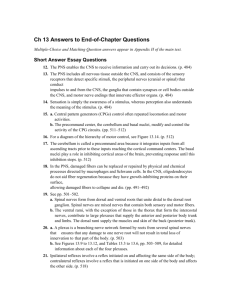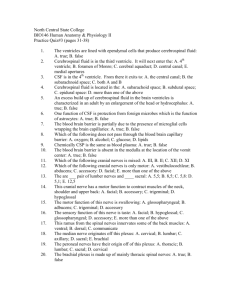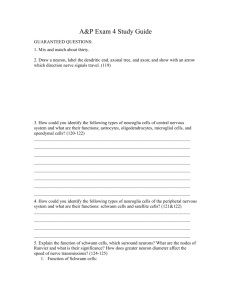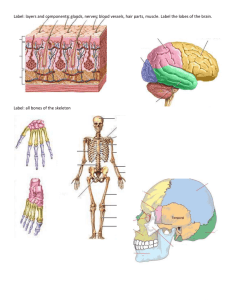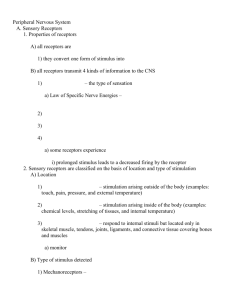Study_Guide_Chapter_13_17
advertisement
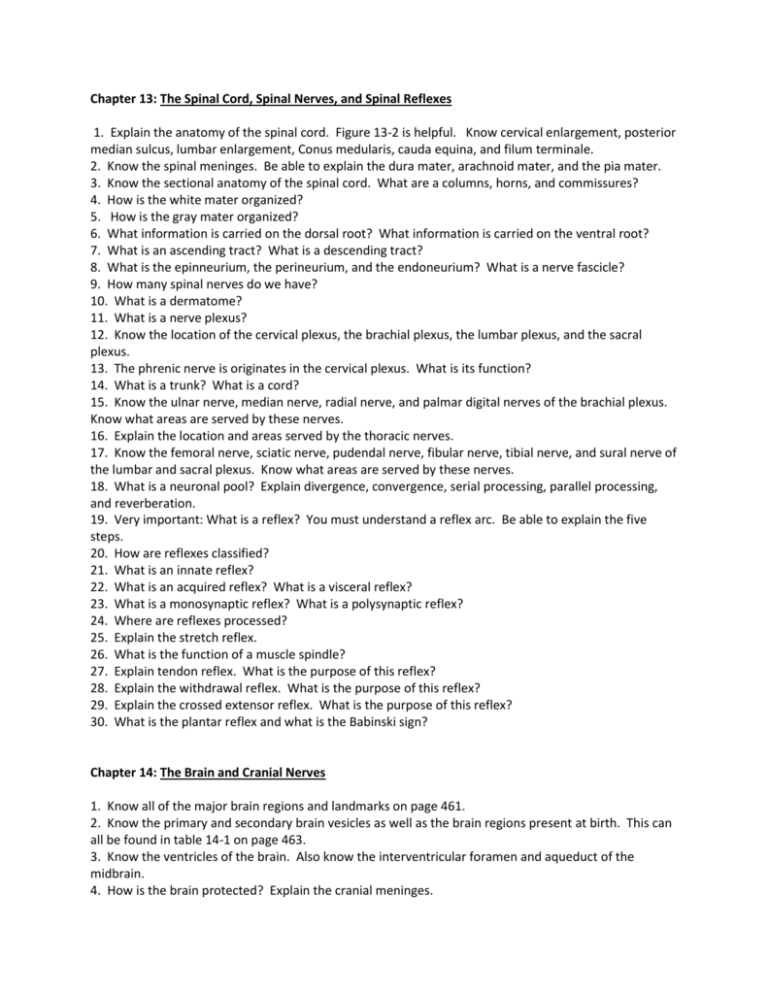
Chapter 13: The Spinal Cord, Spinal Nerves, and Spinal Reflexes 1. Explain the anatomy of the spinal cord. Figure 13-2 is helpful. Know cervical enlargement, posterior median sulcus, lumbar enlargement, Conus medularis, cauda equina, and filum terminale. 2. Know the spinal meninges. Be able to explain the dura mater, arachnoid mater, and the pia mater. 3. Know the sectional anatomy of the spinal cord. What are a columns, horns, and commissures? 4. How is the white mater organized? 5. How is the gray mater organized? 6. What information is carried on the dorsal root? What information is carried on the ventral root? 7. What is an ascending tract? What is a descending tract? 8. What is the epinneurium, the perineurium, and the endoneurium? What is a nerve fascicle? 9. How many spinal nerves do we have? 10. What is a dermatome? 11. What is a nerve plexus? 12. Know the location of the cervical plexus, the brachial plexus, the lumbar plexus, and the sacral plexus. 13. The phrenic nerve is originates in the cervical plexus. What is its function? 14. What is a trunk? What is a cord? 15. Know the ulnar nerve, median nerve, radial nerve, and palmar digital nerves of the brachial plexus. Know what areas are served by these nerves. 16. Explain the location and areas served by the thoracic nerves. 17. Know the femoral nerve, sciatic nerve, pudendal nerve, fibular nerve, tibial nerve, and sural nerve of the lumbar and sacral plexus. Know what areas are served by these nerves. 18. What is a neuronal pool? Explain divergence, convergence, serial processing, parallel processing, and reverberation. 19. Very important: What is a reflex? You must understand a reflex arc. Be able to explain the five steps. 20. How are reflexes classified? 21. What is an innate reflex? 22. What is an acquired reflex? What is a visceral reflex? 23. What is a monosynaptic reflex? What is a polysynaptic reflex? 24. Where are reflexes processed? 25. Explain the stretch reflex. 26. What is the function of a muscle spindle? 27. Explain tendon reflex. What is the purpose of this reflex? 28. Explain the withdrawal reflex. What is the purpose of this reflex? 29. Explain the crossed extensor reflex. What is the purpose of this reflex? 30. What is the plantar reflex and what is the Babinski sign? Chapter 14: The Brain and Cranial Nerves 1. Know all of the major brain regions and landmarks on page 461. 2. Know the primary and secondary brain vesicles as well as the brain regions present at birth. This can all be found in table 14-1 on page 463. 3. Know the ventricles of the brain. Also know the interventricular foramen and aqueduct of the midbrain. 4. How is the brain protected? Explain the cranial meninges. 5. Explain the location of the dura mater, the arachnoid mater, and the pia mater. What is in the epidural space and the subarachnoid space? 6. What are the dural folds? 7. What are the dural sinuses? 8. What are the functions of cerebral spinal fluid? Where is it produced? What is the choroid plexus? 9. Explain the general circulation of CSF. 10. What is the blood brain barrier? What is the function of the BBB? 11. What is the location and basic function of the medulla oblongata? Note the cardiac, vasomotor, and respiratory rhythmicity centers. 12. What is the location and basic function of the pons? 13. What is the location and basic function of the midbrain? 14. What are the three structures that make up the brainstem? 15. What is the location and major function of the cerebellum? 16. Know the basic structure of the cerebellum including the vermis, lobes, folia, and arbor vitae. Where is the fourth ventricle located? 17. How is the cerebellum attached to the rest of the brain? (Peduncles) 18. What is ataxia? 19. What is the location and general function of the thalamus? 20. What is the location and general function of the pineal gland? What is the function of melatonin? 21. What is the location and basic function of the hypothalamus? 22. How is the pituitary gland attached to the hypothalamus? 23. What is the general function of the limbic system? 24. What is the general function of the hippocampus? 25. What is the location and general function of cerebral cortex? 26. What is the difference between a sulcus, fissure, and gyrus? 27. Know the location of the central sulcus, the postcentral gyrus, and the precentral gyrus. 28. Know the location and basic function of the frontal lobe, parietal lobe, occipital lobe, and temporal lobe. 29. What is the location and basic function of the basal nuclei. 30. What are association areas on the cortex? 31. Know the visual cortex, auditory cortex, olfactory cortex, and gustatory cortex. 32. What is meant by hemispheric lateralization? 33. You must the correct order and general function of each of the cranial nerves. I. olfactory nerves II. optic nerves III. oculomotor nerves IV. the trochlear nerves V. the trigeminal nerves VI. the abducians nerves VII. the facial nerves (associated with Bell’s Palsy) VIII. the vestibulocochlear nerves IX. the glossopharyngeal nerves X. the vagus nerves XI. the accessory nerves XII. the hypoglossal nerves Chapter 15: Neural Integration I: Sensory Pathways and the Somatic Nervous System 1. Define a sensory receptor. 2. What meant by the term general senses? 3. What are the special senses? 4. What are free nerve endings? 5. What is meant by the term adaptation? 6. What is the function of a nociceptor? 7. Explain mechanoreceptors. What are tactile receptors, baroreceptors, and proprioceptos. 8. What are tactile receptors? Explain free nerve endings, root hair plexus, tactile discs, tactile corpuscles, lamellated corpuscles, and ruffini corpuscles. 9. What is a proprioceptor? What is a chemoreceptor? 10. What is a first order neuron, a second order neuron, and a third order neuron? 11. What is meant by ‘somatic sensory pathway’? What is the afferent nervous system? 12. What type of information is carried by the posterior column pathway? 13. Does sensory information cross over? What is meant by the term ‘decussation’? 14. What type of information is carried by the spinothalamic tract? 15. What type of information is carried by the spincerebellar pathway? 16. What is meant by the term ‘visceral sensory pathway’? 17. What is the efferent nervous system? What is meant by the ‘somatic nervous system’? 18. Does somatic information cross over? 19. What is a lower motor neuron? What is an upper motor neuron? 20. What type of information is carried by the corticospinal pathway? Chapter 16: Neural Integration II: The Autonomic Nervous System and Higher Functions 1. You are responsible for reading from pages 529-545. The material in this chapter is very important and is critical in A and P II. 2. What are the main functions of the autonomic nervous system (ANS)? 3. How is the ANS organized? 4. What are preganglionic and postganglionic neurons? 5. What are the autonomic ganglia? 6. What are the divisions of the ANS? 7. What is the function of the sympathetic division (SNS)? Note the short preganglionic fibers and the long postganglionic fibers. 8. What is the function of the parasympathetic division (PNS)? Note the long preganglionic fibers and the short postganglionic fibers. 9. Explain the organization of the SNS. What are the sympathetic chain ganglia? Where are they found? 10. Which neurotransmitters are secreted from the pre and postganglionic neurons in the SNS and the PNS? Note: In the SNS Preganglionic fibers secrete acetylcholine (Ach) and postganglionic fibers secrete norepinephrine (NE). In the PNS preganglionic fibers secrete acetylcholine (Ach) and postganglionic fibers secrete Acetylcholine (Ach). 11. What is the function of the suprarenal medulla? Note: It secrets norepinephrine (NE) and epinephrine (E) into the bloodstream. This will amplify the activity of the SNS. 12. What is meant by sympathetic stimulation and the release of NE and E? What type of receptors are stimulated by NE and E? 13. When alpha I receptors in smooth muscle are stimulated they cause blood vessels to constrict, sphincters in the digestive tract and urinary tract to close. 14. When alpha II receptors are stimulated they generally have an inhibitory effect. 15. What happens when beta receptors are stimulated? 16. Explain the organization of the PNS. What neurotransmitters are secreted by neurons in the PNS? 17. What happens when nicotinic receptors are stimulated? 18. What happens when muscarinic receptors are stimulated? 19. What is meant by dual innervation. Chapter 17: The Special Senses 1. What are the special senses? 2. Explain the anatomy of the olfaction. 3. Where are olfactory receptors located? 4. What is meant by olfactory discrimination? 5. Explain the anatomy and physiology gestation. 6. Explain the anatomy of a taste receptor. 7. What are the primary taste sensations? 8. List and explain the major accessory structures of the eye. Palpebrae, eyelashes, conjunctiva, lacrimal apparatus, lacrimal gland, and nasolacrimal duct. 9. What is conjunctivitis? 10. What is the function of lysozyme? 11. Study figure 17-4 on page 568. You will need to know the major structures that are described in lecture. 12. What is the location and function of the fibrous tunic? Know the sclera and the cornea. 13. What is the location and function of the vascular tunic? What is the location and function of the iris? Explain the function of the pupillary muscles. What is the function of the ciliary body? What is the location and function of the choroid? 14. What is the location and function of rods and cones? What is the macula lutea and the fovia? 15. Where is the blind spot located? 16. What is the location of the anterior cavity? Remember that is subdivided into the anterior and posterior chambers. What is this cavity filled with? 17. What is the location of the posterior cavity? What is this cavity filled with? 18. What is the function of aqueous humor? 19. What is the function of vitreous body? 20. Be able to explain image reversal in the eye. 21. Explain myopia and hyperopia. How are they corrected? 22. You are not responsible for the biochemistry of vision on pages 578-581. You can skip this. It is not on the test. 23. Explain color blindness. 24. Explain the visual pathway in figure 17-19. 25. You are responsible for knowing the anatomy of the ear. Figure 17.20 on page 586 is helpful. 26. Explain the structure of the external ear. What is the function of cerumen? 27. Explain the structure of the middle ear. What is the function of the ear ossicles? 28. Know the tympanic membrane and the oval window. 29. What is the function of the tensor tympanni muscle and the stapedius muscle? 30. Explain the structure of the inner ear. Where is perilymph and endolymph found? 31. What is static equilibrium? What is dynamic equilibrium? 32. 33. 34. 35. 36. 37. What is the function of the saccule and utricle? How do they work? Look at figure 17.24. What is the function of the round window? What is the function of the semicircular canals? How do they work? Look at figure 17-23. Explain the structure of the cochlear duct. Explain the structure and function of the organ of Corti. Figure 17-27 is helpful. Be able to explain the hearing process on pages 595-597. Figure 17-29 is helpful.

